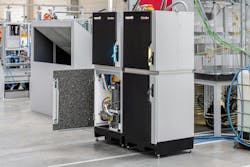Unlocking efficiency: The benefits of variable speed hydraulic pump systems
Reducing costs and promoting energy savings in manufacturing is an increasingly important business objective and operational goal for businesses worldwide. Manufacturers charged with reaching these goals should start with evaluating their hydraulic pump systems. Hydraulics are deeply rooted within U.S. manufacturing processes and many of these conventional systems use fixed speed electric motors, which are known to be inefficient, expensive and environmentally unfriendly.
Operationally, fixed-speed electric motors are in constant motion at full speed, running at 1,200 or 1,800 RPM which requires significant constant power — even when performing no work. The majority of applications that use fixed speed hydraulics only require about half (on average) of the installed energy from the constant motor speed during machine cycles, making the manufacturing process wasteful and inefficient.
Conversely, variable speed hydraulic pump systems have much higher efficiency because, thanks to on-demand adjustable flow of hydraulic fluid and corresponding motor speed, the electric motors operate at a rate that better matches actual system requirements. The return on investment (ROI) and resulting energy savings when using variable speed pump systems is, in large part, thanks to the lower average motor RPM plus the decrease in heat and resulting secondary resources such as cooling.
Amplified savings with modern pump systems
Variable-speed hydraulic pump systems are a necessary feature of efficient machinery and come with a variety of benefits. While there is an upfront cost to consider, they pay for themselves in the benefits they elicit.
Because of the higher initial investment required in building an application with variable speed pump systems, many OEM machine builders still opt for less expensive, conventional fixed-speed hydraulic systems. In order to justify a change to higher initial cost variable speed systems, OEMs should look at the manufacturing process holistically for ROI benefits to their customers. For example, one manufacturer in the plastics processing industry standardized on variable-speed pump systems within its injection molding machine lines, and experienced significant ROI benefits for their customers that led to the OEM increasing their machine sales. Due to the electrical savings and other contributing factors the upfront cost of variable speed was shown to be recovered in just one year of production in plastics machinery.
Promoting energy savings in carbon emitting industries
The plastics industry is well positioned to be an example for promoting energy savings. Plastic contributes to 3.4% of global greenhouse gas emissions through its life cycle, with 90% coming from production and conversion from fossil fuels. The industry has an opportunity to invest in variable speed pump systems, with a goal of ultimately decreasing not only the facility and machine’s emissions, but the industry’s total carbon footprint. Variable speed hydraulics have been proven to be successful in other industries as well; a wide variety of presses, machine tools and metal processing plants have seen significant benefits.
There is a comprehensive approach to sustainability in manufacturing in Europe, including European Union (EU) regulations to reduce emissions by at least 55% by 2030 across multiple sectors. Because of these regulations, variable-speed hydraulic systems have grown in popularity in Europe faster than in the United States.
The US is following the EU on industry regulations but has offered carbon credits as a tax break for companies who limit CO2 emissions. These credits can also be used to counteract the upfront cost of adding variable speed pump systems to operations. Competition from foreign machinery manufacturers is rising in the US as more machines are being imported from Asia and Europe, with pre-installed variable speed hydraulic systems.
To align with carbon emission reduction goals, many larger companies are measuring and reporting how many tons of carbon they are saving (capturing) to help balance the upfront financial cost of the energy-saving machinery.
Secondary benefits of variable speed pump systems
There are additional energy-savings benefits that can be experienced by utilizing variable-speed hydraulic systems. For example, the electrical energy wasted by running a fixed-speed system is directly converted into heat which then requires higher capacity coolant systems and additional machine maintenance. These are upfront and operating costs that can be drastically reduced when implementing variable-speed pump systems.
Additionally, machines with variable-speed pumps that can run at half of the average pump speed of conventional hydraulic systems are far less noisy. It is possible to reduce the average sound power level of hydraulic machinery by 10 to 20 db only by changing to variable-speed hydraulics. Variable speed is an easy method to make the operating environment in a manufacturing plant less stressful and improve overall employee productivity of those who work in close proximity to the machines.
Future considerations
As part of ongoing efforts to reduce operation costs, manufacturers could start by reevaluating conventional hydraulic system designs and consider newer designs like self-contained hydraulic actuators. These self-contained actuators can, in many cases, replace traditional large-oil-reservoir hydraulic systems with greatly reduced oil requirements (up to 90% less oil), while maintaining the same benefits of variable speed and the high-power density of conventional hydraulic systems. OEMs are increasingly interested in this technology because it offers those combined benefits that help reduce energy losses without the need for a large external hydraulic system.
Reducing costs and saving energy should be a high priority for manufacturers, with consideration for increasing government regulations and internal objectives connected to total cost and energy savings. Industry leaders tasked with this responsibility must evaluate the cost-benefit analysis of adopting new technologies such as variable-speed hydraulic pump systems in their operations. By doing so they can meet their business goals, reduce operating costs, lower greenhouse gas emissions and improve overall efficiency.

